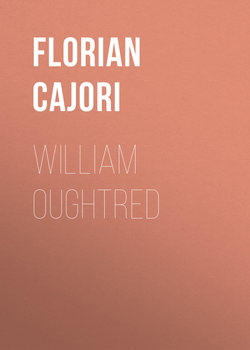Читать книгу William Oughtred - Cajori Florian - Страница 2
CHAPTER I
OUGHTRED’S LIFE
AT SCHOOL AND UNIVERSITY
ОглавлениеWilliam Oughtred, or, as he sometimes wrote his name, Owtred, was born at Eton, the seat of Eton College, the year of his birth being variously given as 1573, 1574, and 1575. “His father,” says Aubrey, “taught to write at Eaton, and was a scrivener; and understood common arithmetique, and ’twas no small helpe and furtherance to his son to be instructed in it when a schoole-boy.”1 He was a boy at Eton in the year of the Spanish Armada. At this famous school, which prepared boys for the universities, young Oughtred received thorough training in classical learning.
According to information received from F. L. Clarke, Bursar and Clerk of King’s College, Cambridge, Oughtred was admitted at King’s a scholar from Eton on September 1, 1592, at the age of seventeen. He was made Fellow at King’s on September 1, 1595, while Elizabeth was still on the throne. He received in 1596 the degree of Bachelor of Arts and in 1600 that of Master of Arts. He vacated his fellowship about the beginning of August, 1603. His career at the University of Cambridge we present in his own words. He says:
Next after Eaton schoole, I was bred up in Cambridge in Kings Colledge: of which society I was a member about eleven or twelve yeares: wherein how I behaved my selfe, going hand in hand with the rest of my ranke in the ordinary Academicall studies and exercises, and with what approbation, is well knowne and remembered by many: the time which over and above those usuall studies I employed upon the Mathematicall sciences, I redeemed night by night from my naturall sleep, defrauding my body, and inuring it to watching, cold, and labour, while most others tooke their rest. Neither did I therein seek only my private content, but the benefit of many: and by inciting, assisting, and instructing others, brought many into the love and study of those Arts, not only in our own, but in some other Colledges also: which some at this time (men far better than my selfe in learning, degree, and preferment) will most lovingly acknowledge.2
These words describe the struggles which every youth not endowed with the highest genius must make to achieve success. They show, moreover, the kindly feeling toward others and the delight he took throughout life in assisting anyone interested in mathematics. Oughtred’s passion for this study is the more remarkable as neither at Eton nor at Cambridge did it receive emphasis. Even after his time at Cambridge mathematical studies and their applications were neglected there. Jeremiah Horrox was at Cambridge in 1633-35, desiring to make himself an astronomer.
“But many impediments,” says Horrox, “presented themselves: the tedious difficulty of the study itself deterred a mind not yet formed; the want of means oppressed, and still oppresses, the aspirations of my mind: but that which gave me most concern was that there was no one who could instruct me in the art, who could even help my endeavours by joining me in the study; such was the sloth and languor which had seized all… I found that books must be used instead of teachers.”3
Some attention was given to Greek mathematicians, but the works of Italian, German, and French algebraists of the latter part of the sixteenth and beginning of the seventeenth century were quite unknown at Cambridge in Oughtred’s day. It was part of his life-work as a mathematician to make algebra, as it was being developed in his time, accessible to English youths.
At the age of twenty-three Oughtred invented his Easy Way of Delineating Sun-Dials by Geometry, which, though not published until about half a century later, in the first English edition of Oughtred’s Clavis mathematicae in 1647, was in the meantime translated into Latin by Christopher Wren, then a Gentleman Commoner of Wadham College, Oxford, now best known through his architectural creations. In 1600 Oughtred wrote a monograph on the construction of sun-dials upon a plane of any inclination, but that paper was withheld by him from publication until 1632. Sun-dials were interesting objects of study, since watches and pendulum clocks were then still unknown. All sorts of sun-dials, portable and non-portable, were used at that time and long afterward. Several of the college buildings at Oxford and Cambridge have sun-dials even at the present time.
1
Aubrey’s Brief Lives, ed. A. Clark, Vol. II, Oxford, 1898, p. 106.
2
“To the English Gentrie, and all others studious of the Mathematicks, which shall bee Readers hereof. The just Apologie of Wil: Ovghtred, against the slaunderous insimulations of Richard Delamain, in a Pamphlet called Grammelogia, or the Mathematicall Ring, or Mirifica logarithmorum projectio circularis” [1633?], p. 8. Hereafter we shall refer to this pamphlet as the Apologeticall Epistle, this name appearing on the page-headings.
3
Companion to the [British] Almanac of 1837, p. 28, in an article by Augustus De Morgan on “Notices of English Mathematical and Astronomical Writers between the Norman Conquest and the Year 1600.”
